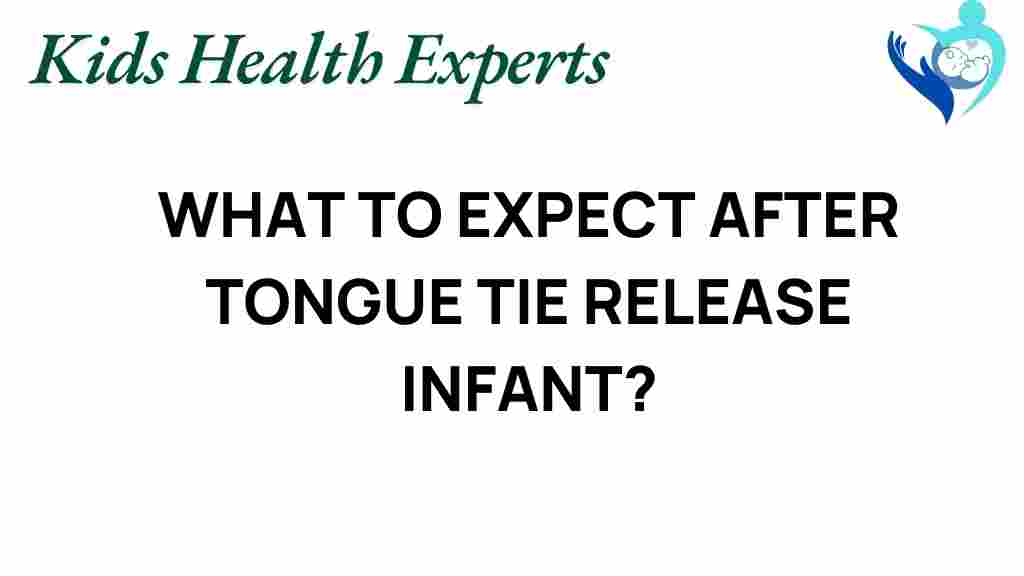Tongue tie, also known as ankyloglossia, can significantly impact an infant’s ability to breastfeed effectively, which can lead to various challenges in both feeding and overall infant health. If you’re considering a tongue tie release for your baby, it’s essential to understand what to expect during the recovery process. This guide will provide valuable insights into the recovery journey, breastfeeding adjustments, and the impact on speech development, all while offering parent guidance to ensure optimal pediatric care.
Understanding Tongue Tie and Its Implications
Tongue tie occurs when the band of tissue connecting the tongue to the bottom of the mouth is too tight or too short. This condition can lead to issues with:
- Breastfeeding difficulties
- Oral health problems
- Speech delays
Addressing tongue tie early on can enhance infant health, improve breastfeeding success, and set the stage for proper speech development as the child grows.
The Tongue Tie Release Procedure
The release of a tongue tie is a quick and typically straightforward procedure performed by a qualified pediatric healthcare provider. Here’s what you can expect:
- Consultation: Your pediatrician or lactation consultant will evaluate your infant’s oral health and feeding patterns to determine if a release is necessary.
- Procedure: The actual release can be done in a few minutes using a laser or scissors. Most infants experience minimal discomfort.
- Immediate Aftercare: Post-procedure, you may be instructed to take your baby for a short feeding session to promote healing and assess immediate improvements.
Recovery After Tongue Tie Release
Recovery from a tongue tie release is usually quick, but parents should be aware of the following aspects:
- Pain Management: Some infants may experience mild discomfort. It’s essential to monitor your baby and consult your pediatrician for guidance on managing any pain.
- Feeding Adjustments: You might notice changes in your infant’s feeding patterns. Some may latch on more effectively, while others may need time to adjust.
- Oral Care: Gentle oral care is vital to prevent infections. Your pediatrician will provide instructions on how to care for the area.
Breastfeeding After Tongue Tie Release
Breastfeeding is often significantly improved after a tongue tie release. Here are some tips for breastfeeding success:
- Positioning: Experiment with different positions to find the most comfortable one for both you and your baby.
- Latching Techniques: Encourage your baby to latch deeply to maximize milk transfer and comfort.
- Frequent Feeding: Offer the breast more frequently to help establish a good milk supply and encourage better latching.
Many parents find that consulting with a lactation specialist post-procedure can significantly aid in navigating these adjustments. For more information on breastfeeding support, visit Lactation Consultants.
Signs of Complications to Watch For
While complications are rare, it’s essential to be aware of the warning signs that may indicate issues during recovery:
- Excessive bleeding: If your baby has bleeding that doesn’t stop within a few minutes, contact your healthcare provider immediately.
- Fever: Persistent fever may indicate infection, requiring medical assessment.
- Difficulty feeding: If your baby struggles to latch or feed effectively, further evaluation may be necessary.
Impact on Speech Development
In addition to improving breastfeeding, releasing a tongue tie can have a long-term positive impact on speech development. Proper tongue mobility is crucial for clear articulation and the development of oral motor skills. Here’s what to keep in mind:
- Early Intervention: Addressing tongue tie early can prevent speech delays and promote healthy articulation.
- Ongoing Monitoring: Regular pediatric care and check-ups can help assess your child’s speech development milestones.
- Speech Therapy: For some children, working with a speech therapist may be beneficial to develop proper speech patterns.
Pediatric Care and Follow-Up
After a tongue tie release, regular follow-ups with your pediatrician are essential to ensure your infant’s health is on track. During these visits, your healthcare provider will:
- Assess Feeding: Evaluate your breastfeeding success and address any feeding concerns.
- Monitor Oral Health: Check for proper healing and oral health development.
- Track Developmental Milestones: Ensure your child is meeting speech and physical development milestones.
Parent Guidance for Optimal Recovery
As a parent, you play a crucial role in your infant’s recovery journey. Here are some tips for providing the best guidance:
- Stay Informed: Research and understand the implications of tongue tie and the recovery process. Knowledge empowers you to make informed decisions.
- Seek Support: Connect with other parents or support groups who have gone through similar experiences. Sharing can provide comfort and practical advice.
- Communicate with Healthcare Providers: Don’t hesitate to ask questions or express concerns to your pediatrician or lactation consultant. Open communication is key to effective care.
Troubleshooting Common Issues
Even with the best intentions, challenges may arise during your baby’s recovery. Here are some common issues and tips on how to troubleshoot them:
- Persistent Pain: If your baby seems to be in pain beyond the expected recovery time, consult your pediatrician.
- Feeding Refusal: If your baby refuses to feed, try different feeding positions and ensure they are comfortable.
- Speech Concerns: If you notice delayed speech development, consider scheduling an early evaluation with a speech therapist.
Conclusion
Navigating the recovery journey after a tongue tie release can be a transformative experience for both infants and parents. Understanding the process and knowing what to expect can significantly ease the transition. With proper pediatric care, effective breastfeeding techniques, and attention to oral health, you can help ensure that your child thrives both in the immediate aftermath of the procedure and in their long-term development.
As you embark on this journey, remember to remain patient and observant. The path to recovery may have its bumps, but with the right guidance and support, your infant can enjoy improved health, enhanced feeding experiences, and a brighter future for speech development.
This article is in the category Care and created by KidsHealthExperts Team
